How to choose the best motorcycle helmet for you
Published on: 13 August 2021
Let me kick off by saying that this review, and the video that accompanies it, are probably aimed at less experienced motorcyclists; those who are perhaps a little confused when it comes to choosing a motorcycle helmet.
If you’ve been riding for many years and are really in to your gear, you might not get much from what follows; and this is not going to be a 10-minute jobbie. One of my many critics recently pointed out that I was like his dad. Ask him the time, and he’ll tell you how to build a clock. He has a point, but what we enjoy is putting information out there for those who need help. And that’s something we don’t want to rush.

We’re going to cover a lot of ground here, but we have done a video already about how to fit a helmet. We’ll be covering some of the same ground in this article, but not in as much depth. This review is more about how to choose a helmet, and not so much about how to fit it.
Our starting point is that, as a motorcyclist, a helmet is the most important purchase you’ll make. It’s more important than a jacket, a pair of gloves or boots. In truth, it’s more important than the bike. Bikes are dangerous; they can kill you. A helmet can save your life and reduce the chances of brain damage. Remember, brains cannot be repaired. Brain damage is for life.

Personally, we cannot understand those who will think nothing of spending £1500 on an exhaust system, but who then bulk at £300 for a helmet. This may be borne out of a misconception about helmets; that they all meet the same standard. After all, they are all ECE 22-05 accredited. But that’s not the case. Cheap helmets need to meet the standard, and by and large they do. But, of course you can find a helmet that is ECE 22-05 accredited for £25 at Lidl. In fact, studies have shown that many cheaper helmets fail to meet the standard, but the truth is that 22-05 is not a very demanding standard. When you buy a more expensive helmet from one of the more prestigious names, you are buying a safer helmet because the big boys test to a much higher standard, and randomly test helmets as they come off the production line in the way that the budget brands don’t.
Since this was written the new standard is now 22-06. Read about ECE 22-06. The new safety standard for motorcycle helmets
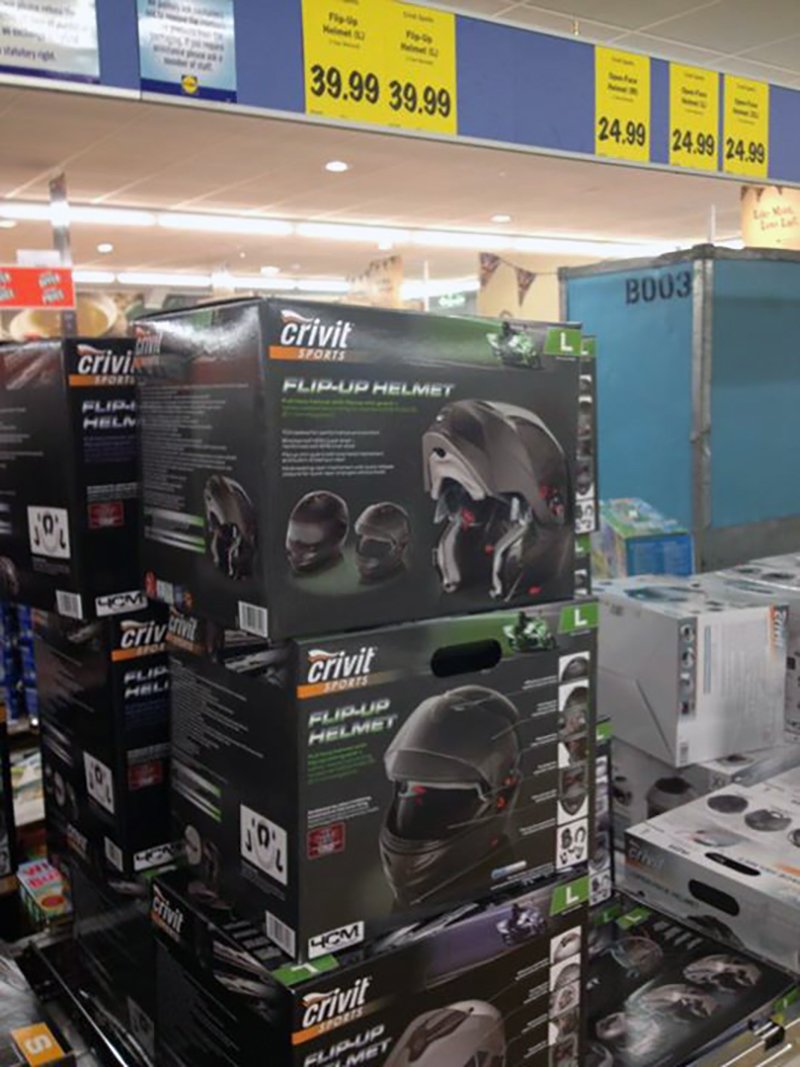
We are not adherents to the adage that you always get what you pay for. Many motorcyclists buy expensive gear that is totally wrong for their needs, and these people could often have got a better result for less money. But a helmet is not something you should skimp on. Our view is that you should buy the best, and suck it up. But that’s not the same as over paying. We are not huge fans of super-expensive carbon helmets. They may be light, but they are not more protective. If you want to pay loadsa money for fancy graphics or a rider’s name, that’s up to you. Likewise if you want to pay high-end money for a really basic, so-called retro helmet with fancy leather trim, that’s up to you. Be a fashion victim, by all means; but don’t go thinking that by spending a lot of money, you’re necessarily buying a high-end helmet.
I have already mentioned that we have done a comprehensive video on helmet fitting, but I still need to go over the basics, because there’s stuff you need to know when buying any helmet.
The fit is important for a number of reasons. A well-fitting helmet will be safer. A well-fitting helmet will not give you a headache; and a headache when you’re riding is to be avoided at all costs. A well-fitting helmet will be quieter, and it will last longer.
Getting a helmet to fit you is not solely about the circumference of your head; it’s not like buying a cap. We all have differently shaped heads. And all helmet brands have different internal shapes. With some brands, the shape even changes from model to model.
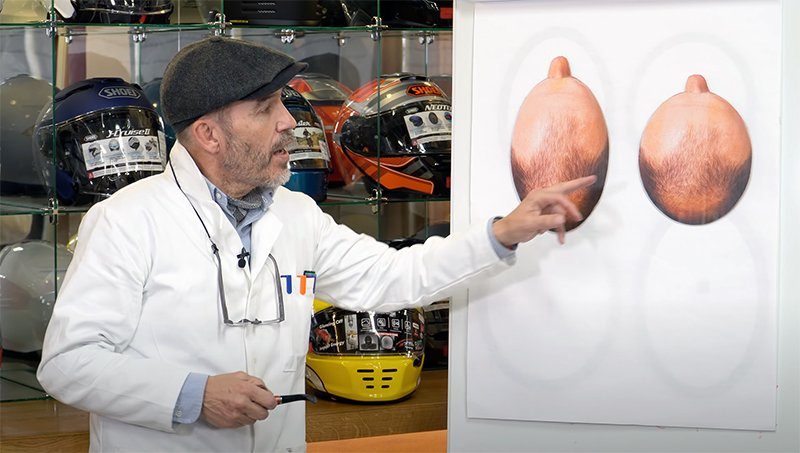
What this means is that you can’t measure your head, then order online in the knowledge that the helmet you choose will fit you. If your head measures 58cm, but is very round you might not work in an oval-shaped Shoei. You could end up with tightness on the sides of the skull. Likewise, if you have an 58 cm head that is oval shaped, you might find a rounder helmet like a Schuberth or a Shark too tight on the forehead.
The secret is to find a helmet in your size that matches the shape of your head. Once you’ve done that, only then should you look at the colours and graphics.
Here at Motolegends, we are particular fans of a Shoei or Arai helmet is because, in every size, there will be an option to fit thinner or thicker cheekpads and thicker or thinner headliners. These are not the only brands that offer this facility, but these giants of the helmet business do it better than anybody else.
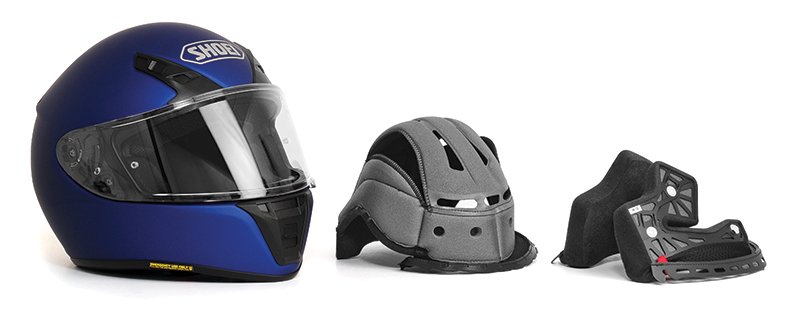
When you go to a shop to buy a helmet, you should expect that the sales assistant is going to take care to get it right. You should expect the sales assistant to undertake a number of tests on any helmet that you try on. If you’re trying on a Shoei or an Arai, you should ask them to show you the difference when other liners are fitted.
If, in a shop, somebody tells you the helmets are over there, and that you should buy whatever feels comfortable, turn around and walk out. Do the same if their only response to a tight helmet is that it will bed in over time. If you are going to spend £300, £400 or more, you have a right to expect some expert assistance.
A word on fit. Comfort is crucial, but not at the expense of safety. A helmet that is too large will often feel comfortable, but that doesn’t mean the fit is right. What you need to look for is a some space between the visor rim of the helmet and the forehead, because as you get hotter your head will expand; and this is when you can experience a headache. The cheeks we want to be as tight as you can bear. A definite chipmunk-cheek is what we are looking for; at the time of purchase, your teeth brushing the inside of your cheeks is fine. Taking chunks of flesh out of them when you talk is perhaps a step to far!
Another point. Take this process seriously. The right helmet fit for you is a helmet that fits you well. Don’t go into the shop with too many demands about colour, closure mechanisms and other features, because as you narrow the field, the chances of getting a good-fitting helmet are reduced. When you bang your head hard, you will find all of those other features to be of little consequence!
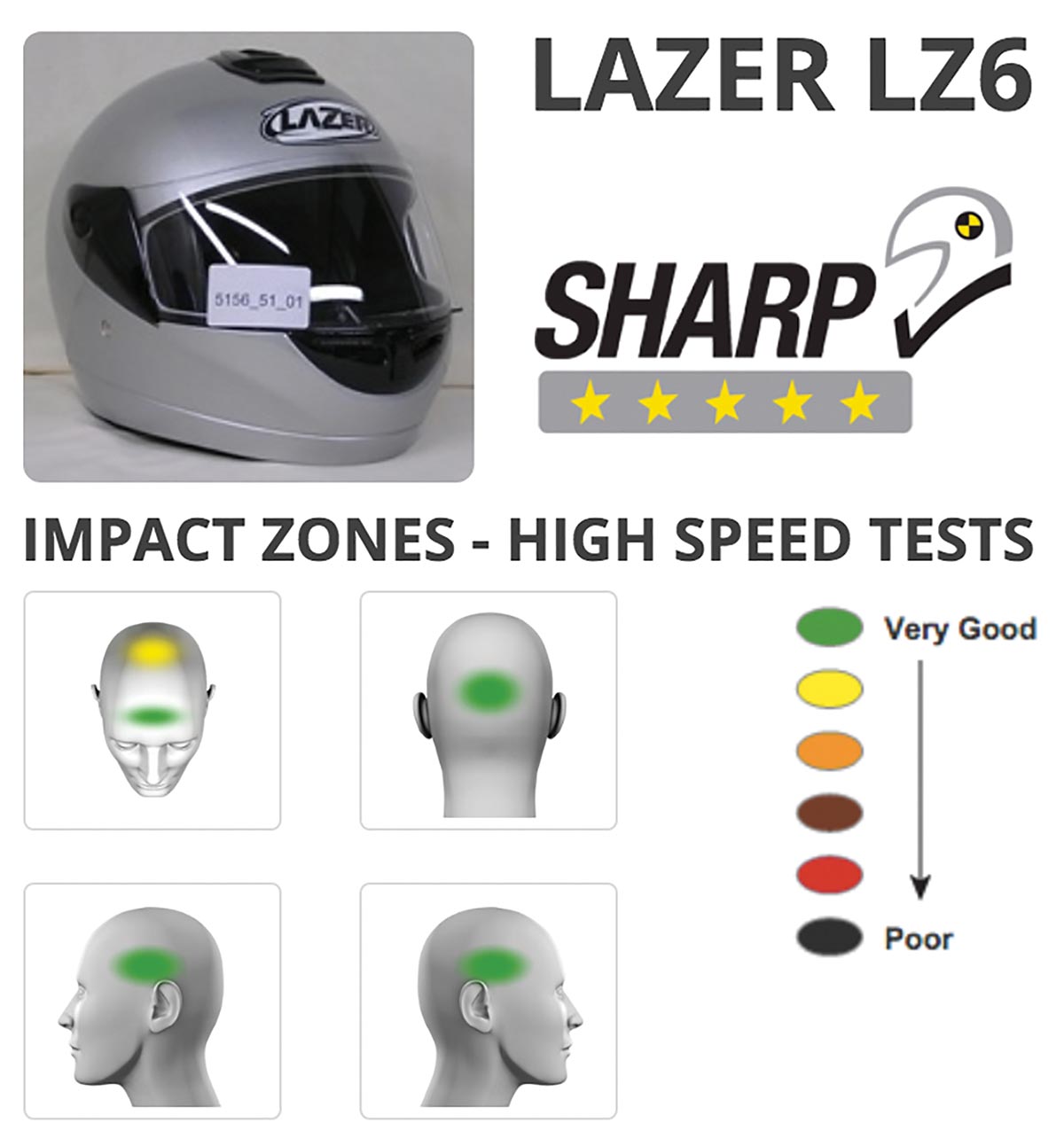
Finally, don’t take too much notice of the SHARP test. Within the industry it holds little sway. The idea behind SHARP was a good one. The execution of that idea was much compromised, however. At launch, SHARP gave a five star rating to a £60 thermoplastic helmet and three stars to an Arai. That tells you everything you need to know about SHARP.
What I am going to do now is talk through all the different styles of helmet in an attempt to help you work out what kind of helmet is going to work best for you.
I am going to be very frank, and talk through the strengths and weaknesses of all the styles. Now if you’ve been riding for a hundred years and rarely need Wikipedia for anything, get out now. You won’t learn anything, and you will resent us for the time you wasted.
In terms of styles, we are going to talk about open-face helmets and open faces with full-face visors, full-face helmets, retro full-face helmets, flip-lids, flip-overs, adventure helmets, and retro off-road helmets.
Let’s go.
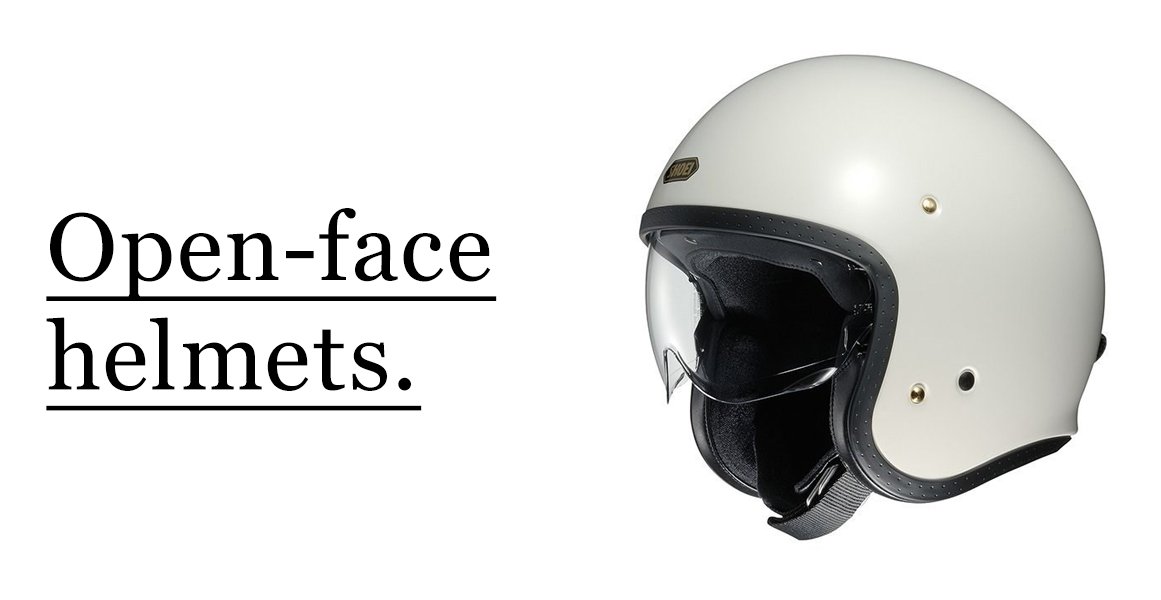
Open-face helmets are fantastic. Those of a certain age will remember when that’s what everybody wore. You get that wind-in-your-hair feeling with an open-face that simply cannot be replicated in a full-face helmet. If I am pottering about on a Sunday morning in the summer, I will often wear my open-face helmet. There’s nothing more exhilarating.
Open-face helmets are tested to the same standard as all helmets, but what cannot be avoided is that they offer no protection to the chin. Come off the bike and you will normally have no control over what happens. If your chin comes into contact with just about anything, it will come off worse. Open face helmets are also very noisy. If you are not to go deaf you really do need to wear earplugs with an open-face helmet. And, of course, they are useless in the rain!
We don’t like to sell open-face helmets to beginners. They are simply not as protective or practical. It is not for us to tell anybody what to wear, but open-face helmets are more dangerous; and that is fact.
When you first try on an open-face helmet and look in the mirror you will think that it makes your head look enormous. It doesn’t; it’s just that we don’t normally look at ourselves with a bowling ball on our head. When you’re wearing a full-face helmet, you simply don’t see how small your head looks inside it!
Some people, particularly hipsters and Harley riders, can get obsessed by the profile of an open-face helmet; in other words how closely it follows the shape of the head. This is an American thing, from a country where, in some circles, any helmet wearing is still sneered at. We understand the desire to look good on the bike, but in general low profile helmets are less comfortable and less protective. We think the obsession with profile is ridiculous. The main purpose of a helmet is to protect your brain. It is not a fashion accessory.
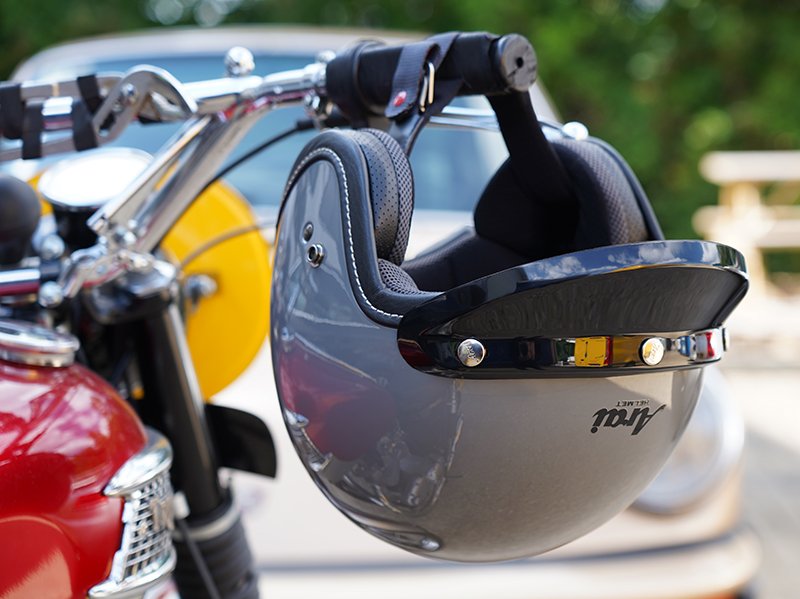
In styling terms, there are different kinds of open-face helmet. They all have a bit of a retro look, but the most retro ones have poppers on the brow to take a peak, and are designed to be worn with goggles. Others come with drop-down visors. Some have poppers to take a bubble visor; these give you that authentic 70s’ look, but these external visors tend to steam up easily in the cold and rain.
A variation on this theme are those helmets with full-face, lift-up visors. These helmets offer no extra protection over pure open face helmets, but are nonetheless popular with a certain kind of rider.
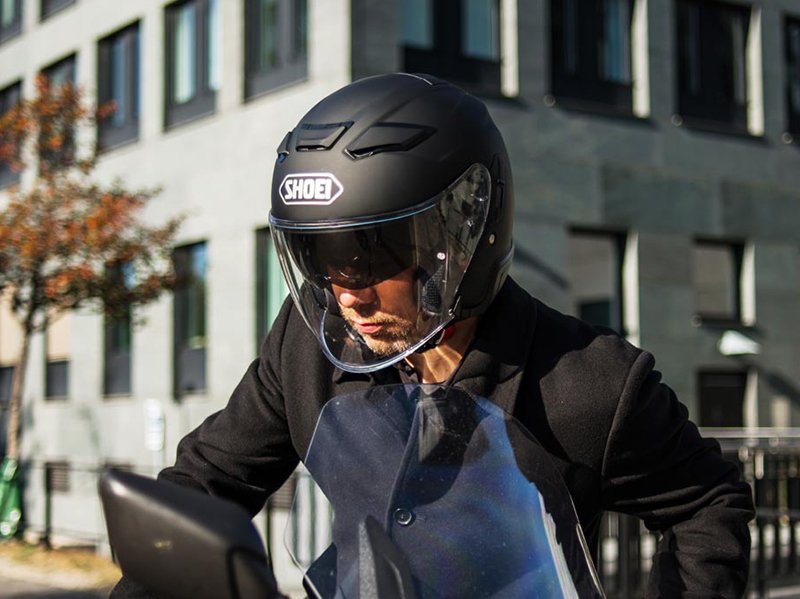
That kind of rider will often ride a big cruiser with a large screen. The airflow behind these screens is often near non existent, and so to keep cool, particularly if you’re touring in a hot country, these visored open-face helmets can be helpful if you want avoid boiling over.
The full visor means that you can us comms. on these helmets far more effectively than you can if you wear a traditional open face. These helmets also offer more protection from the elements than do normal open-face helmets. Your eyes won’t water at 70 mph, and although not exactly quiet they are normally quieter than a traditional open face.
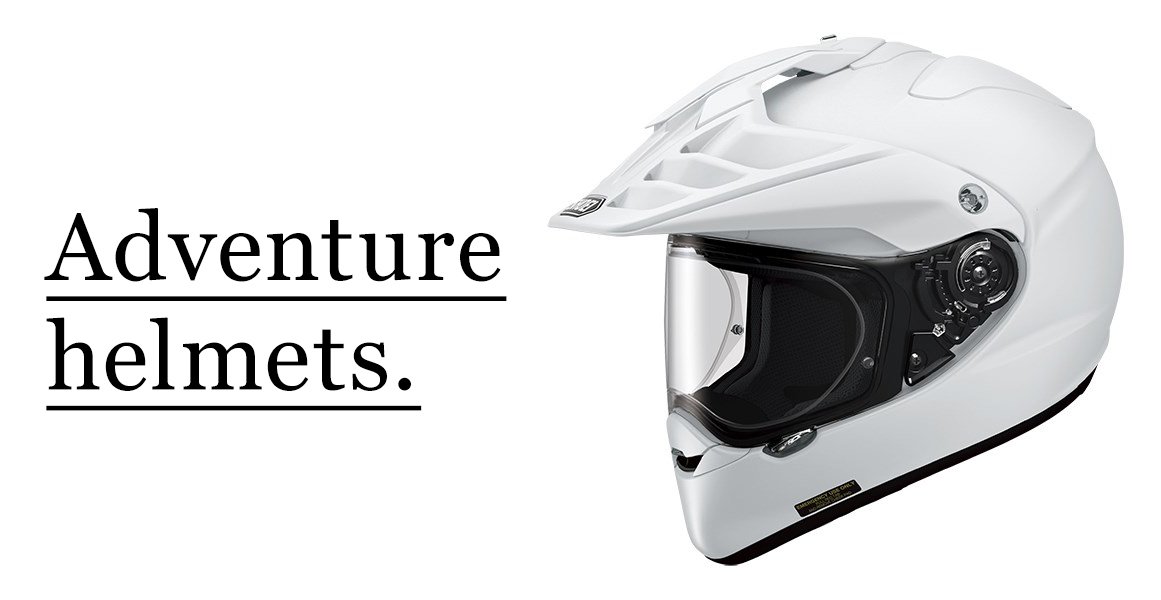
Here at Motolegends, we don’t sell pukka off-road helmets; the kind of helmet you would wear if you competed in enduros. These are specialist helmets in a field in which we are not specialists.
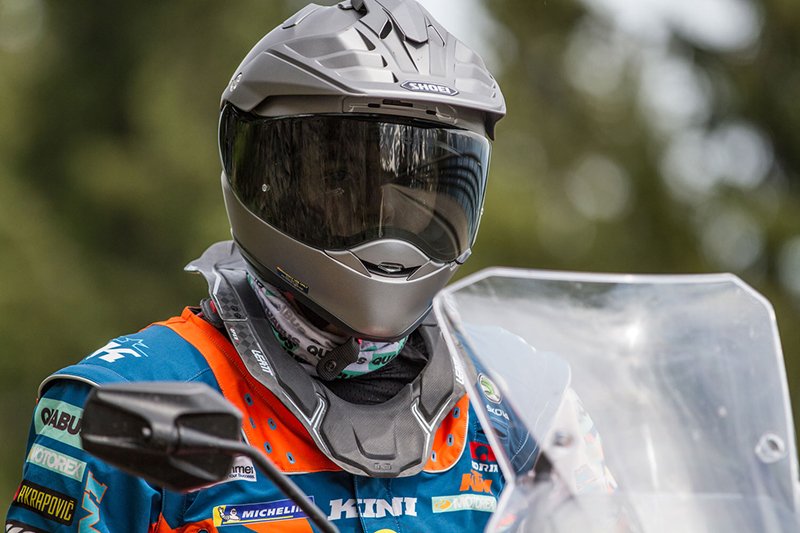
But we do sell adventure helmets. These take their inspiration from the off-road helmet, but are softened somewhat to take into account the fact the adventure bike rider will spend a good part of his time on the black top. The biggest difference between a pure off-road helmet and an adventure helmet is the provision of a visor. The visor provides protection from the elements, flying stones, wasps that don’t get out of the way, and so on.
Most adventure helmets are fashioned like off-road helmets. And this can make them particularly versatile. The facial aperture will usually be quite large. This will allow large amounts of air to reach the face if it’s hot. The visors are often removable so that you can wear an adventure helmet with goggles if you on safari!
Adventure helmets, like off-road helmets have extended noses. This is a benefit in hot weather because it will more easily allow you to take in, and expel, air. The longer nose might also be considered beneficial in the off-road environment where, frankly, there’s a greater possibility that you’re going to face plant the ground!
But perhaps the defining feature of an adventure helmet is the peak. Peaks are a mixed blessing. The main idea is that if you are riding on the savannah into the setting sun, you can reduce the glare by simply dipping your head. And yes maybe this can be useful but many, if not most, adventure helmets come with an internal, drop-down visor. And in our view this does more or less the same job.
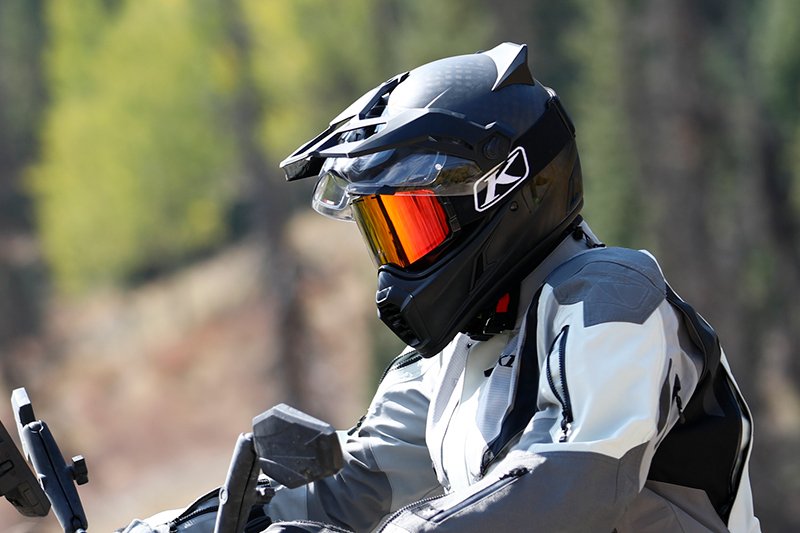
Some commuters claim to like the peak for their early-morning good west-to-east ride into work and their east-to-west return home. And fine, some people reckon that a peak works better for them than a drop-down sun visor. But the truth is that most people buy a helmet with a peak in order to look the part on their adventure bike. They’ve acquired a suit with a removable membrane and a pair of boots with clips up the shaft. They’ve got metal boxes that they find crucial when picking up groceries at Waitrose. All they need to complete the look is an adventure helmet. Again, far be it for us.........
But there are downsides to helmets with peaks. A peak will invariably add noise. But dependent on your height, the height of the saddle and the height of the screen, a peak can create buffeting. And often there’s no solution but to remove the peak. On the subject of peaks, some are robust and affixed to the helmet very solidly. Some are flimsy and flexible. The former are better and less problematic than the latter.
But adventure helmets are also noisy for another reason. Noise is often about air coming into the helmet under the chin. When the air reaches the ears it is received as noise. With their extended chins, adventure helmets allow more air into the helmet than normal full-face helmets. The leader of this particular pack is the new Arai Tour-X5 helmet introduced early in 2024.
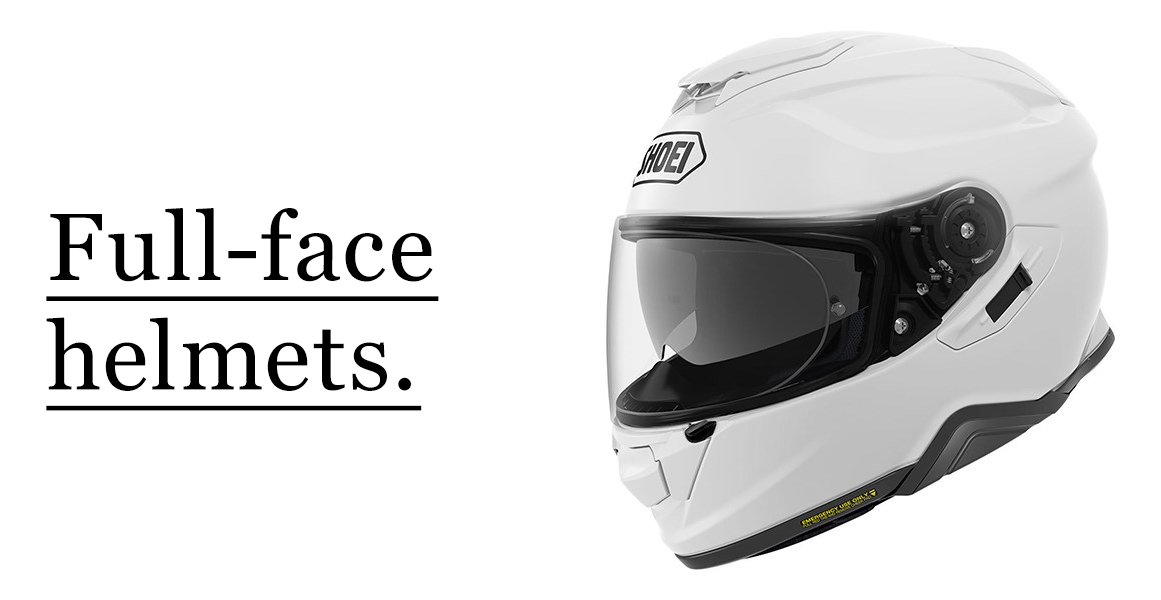
The full-face helmet is the most common style. It is the go to choice for many bikers. It is pretty versatile. From Shoei you have either the Shoei GT Air 3 or the Shoei NXR 2. Both have advantages and disadvantages for different bikers.
But in this article we cannot do justice to the panoply of styles and design features that you’ll find on different helmets. Some are super light. Some are not. Some are cheap; some are expensive. Some are supremely comfortable. Some are quite quiet; others quite noisy. Some have drop-down sun visors. Some come with anti-fog inserts. Some are pre-wired for comms. And so on.
For most people, a full-face will be the obvious choice; the sensible choice. You get all-round protection in the event of an accident. The visor will protect you from the cold and the rain.
We are going to go on and talk about the benefits of a flip-lid over a full-face, but for many people a full face helmet is going to be the right decision. If the racing aesthetic appeals to you, then you will probably be drawn to a full face helmet, and indeed some full-face helmets have a more aggressive profile that closely mimics the helmets worn by Moto GP riders.
In fact, we would suggest that most people on a sportsbike of any description will find themselves in a full-face lid. In the same way that an adventure helmet looks right on a big GS, anything but a full-face looks just a little bit wrong on a machine with sporting pretensions.
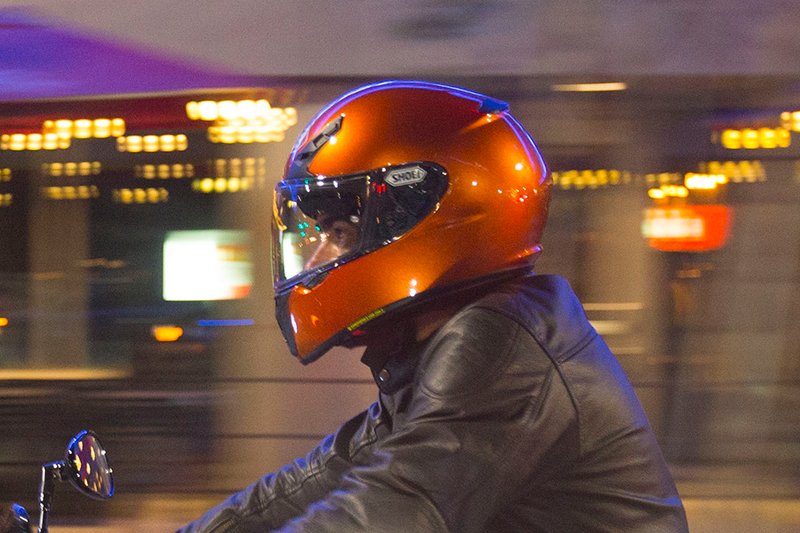
The reality is that you will never look incorrectly attired in a traditional full-face helmet. That won’t make finding the right one any easier because the choice out there is so huge. Once again, we would come back to fit. To get the best out of a full-face helmet, you need the right fit. But that applies equally to any helmet, I suppose.
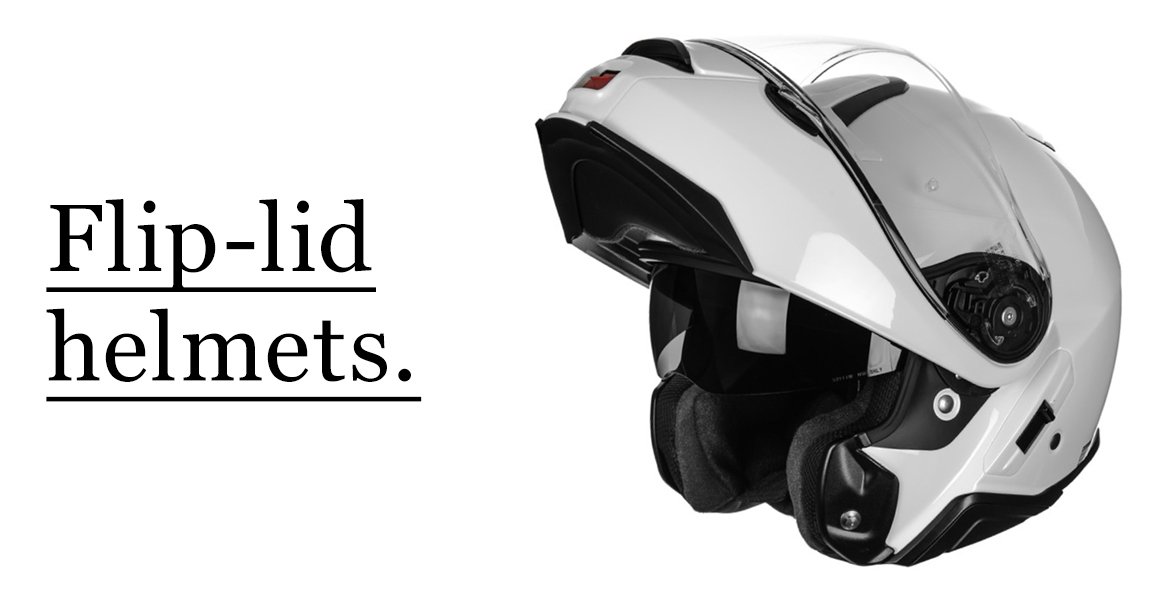
In motorcycling, as in life, there are no truths; just shades of opinion. And so the ‘truth’ you will hear from us is based on our liking of flip-lid helmets. We do not see a downside with flip lids. Nevertheless, we will balance our views and experience with those from people who are not so smitten.
I came to bikes in the eighties. Of course, I rode a sportsbike. We would mercilessly rag anybody who rode on a BMW or in a flip-lid helmet. Often, of course, these people were one and the same. We would ask them whether their panniers contained their pipes and slippers. My, did we think we were funny! Flip-lid helmets were for old duffers and, of course, the police; the avowed enemy of the one-piece, leather-clad sportsbike rider. Flip-lid helmets were much derided, and many of those who were biking back then still harbour the same, unthinking prejudice. But that was then, this is now. Times have changed. Technology has moved us forward, and personally we can only see the benefits that come from riding in a flip helmet.
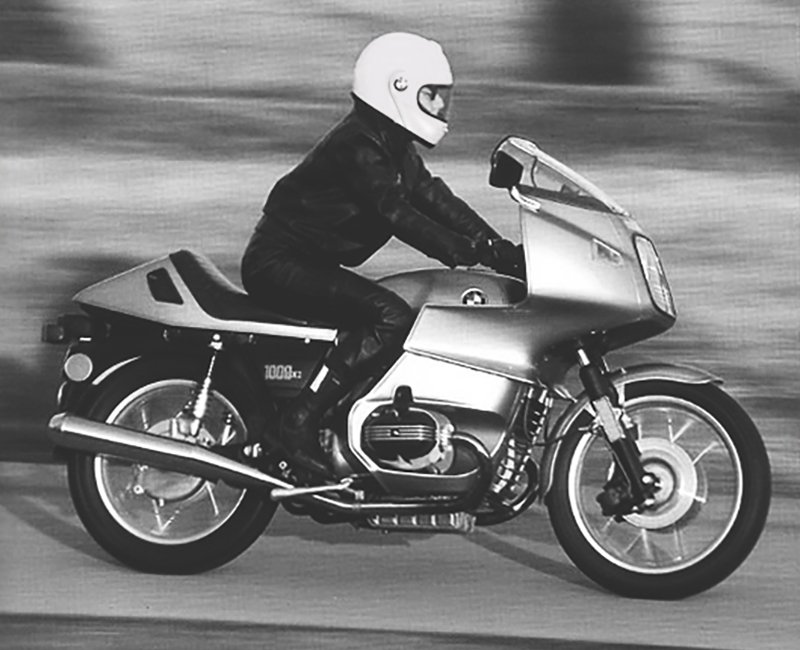
Many people think that the main benefits of a flip-lids are that you can ask for directions or buy petrol without taking it off. A lot of people realise that they are useful in town when you want a bit of cool air. Whilst some like them because you can ride whilst smoking. Heaven forfend!
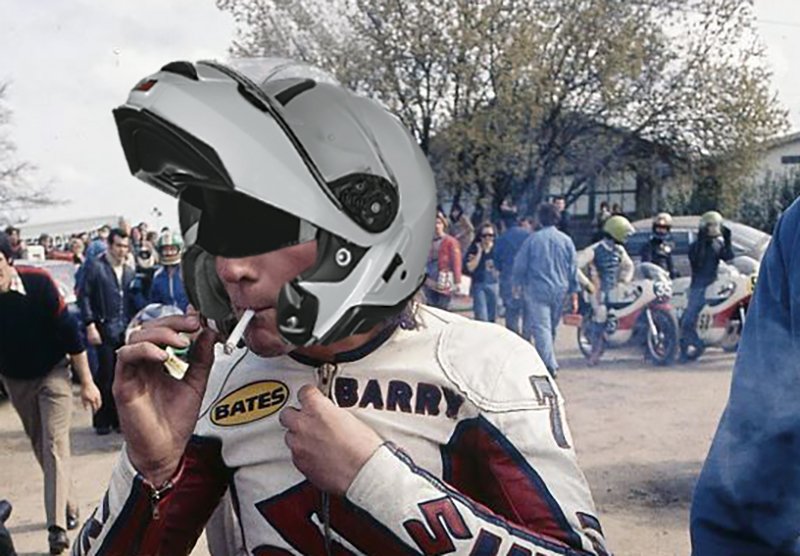
But the main benefit of a flip lid is that it has the potential to be quieter than a full-face helmet. That doesn’t mean that all flip-lid helmets are quiet. Cheap flip lids are not particularly quiet; they are just cheap. But the quietest helmets on the market are flip-lids. We are talking about helmets like the Shoei Neotec 3, the Schuberth C5 and indeed the Schuberth c3 Pro.
These helmets are quiet because they have neck rolls tha fit tightly against the neck. And they can have this because of the way we put them on. The aperture on the underneath of a full-face helmet has to be wide enough to allow the widest part of your skull to pass through it. Because we pull the sides of a flip lid apart and the slide it on to our head from the back, the aperture on a flip-lid can be much smaller. This tight fitting of the neck roll stops air from entering the helmet. And air entering the helmet and reaching the ears is noise.
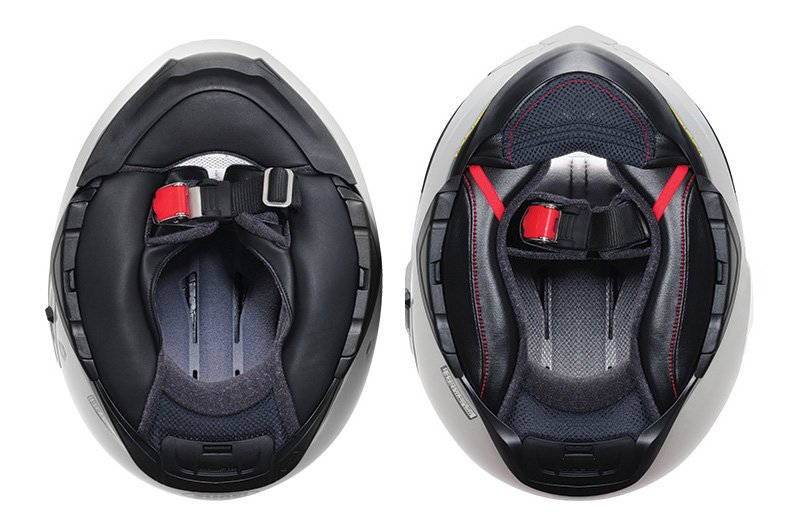
So in addition to the aforementioned benefits, a flip-lid is a quiet lid, which is why it is the staple choice of the long-distance commuter and of those who tour extensively. All motorcycle helmets cause damage to our ears. But a good flip lid potentially causes less damage.
One point we would make is that, even though some helmets are dual homologised, and so can be worn open or closed, you wouldn’t ride with the chin bar up at much more than 30 mph. And so you might ride through town with the chin up, but probably not on the open road. If I am riding down the D roads in France in the summer, I will often ride through the 50 kph villages with the chin bar up in order to cool down, but will then click it locked as I pick up speed outside the village. With the chin bar up, your helmet has the aerodynamics of a barn door, so it doesn’t make sense to ride with it open at speed for all kinds of reasons.
Now some people don’t like flip lids because they reason they are less protective because the chin is a separate component. Now, I am no engineer, but I would not argue with this from a theoretical standpoint, but I have never heard of the chin piece of a flip-lid helmet collapsing in an accident. It also has to be said that the chin is not a high impact zone on a helmet. Most impacts, and of course the most concerning ones, are around the skull.
But whatever the theoretical position, there is one very distinct and unarguable safety argument in favour of a flip lid. If you have an accident, even qualified first responders hesitate to remove a helmet. It is a dangerous and delicate job that requires the attention of two knowledgeable people. But the red button on a flip lid makes it clear to emergency personnel that the chin bar can be raised. This can be done without risk to the motorcyclist, and allows the airways to be easily checked. You can even have someone perform mouth-to-mouth without removing the helmet.
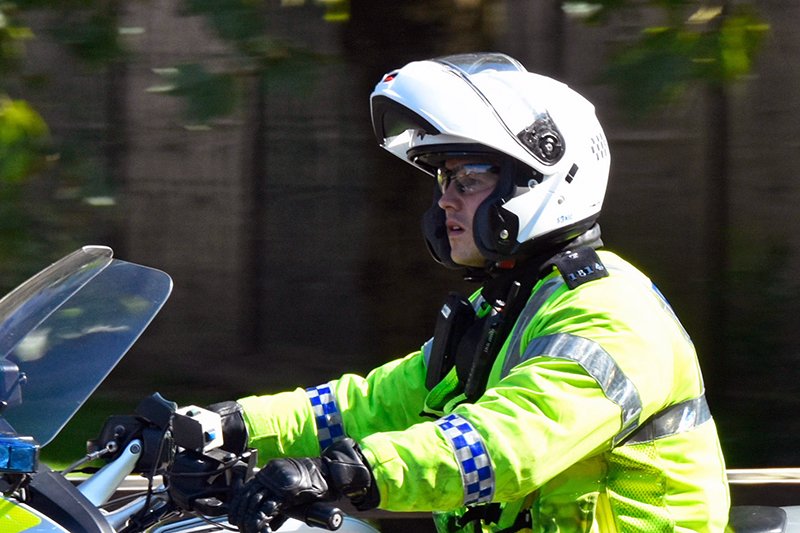
Policeman, Blood Runners and indeed many other professional riders ride in flip lids. We simply don’t see the downsides; only the upsides. And when the chin is closed nobody can tell what kind of helmet you’re wearing, so we just don’t understand those who won’t countenance a flip-lid.
Yes, we would concede that a flip-lid doesn’t look right on a race bike, and flip lids may lack the cool factor that is sought by custom and retro bike riders, but even then our view would be that the practical benefits will often outweigh considerations of style.
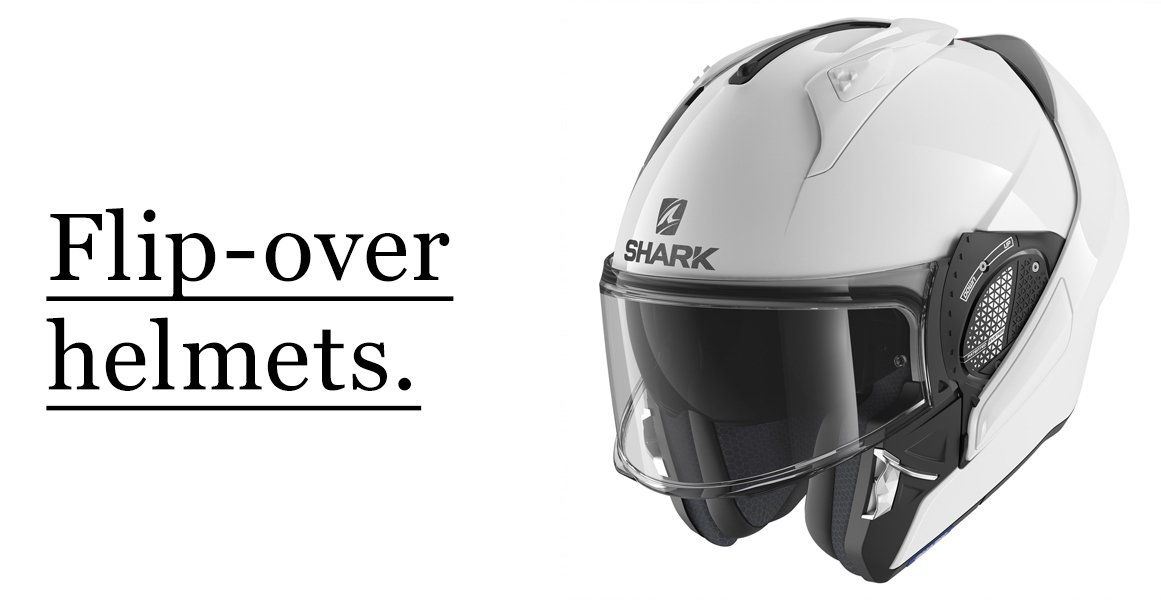
There are a few helmets out there where the chin bar can be taken to the back of the helmet, leaving you with a truly practical open-face helmet as well as a proper full-face one. Surely the best of both worlds!
Well no, not necessarily. These helmets, and I’m thinking particularly of the Shark Evo series and various Roof helmets, are probably better as open face helmets than they are as full-face helmets. They are designed more for the urban commute than for the open road.
In Paris and Milan and other European metropolitan cities they are hugely popular. For your ten minutes you’re flying along the outer ring-road you wear it as a full face. For the 30 or 40 minutes that you’re in the hot traffic making your way to your place of work you wear it as an open-face helmet. And that makes sense. But these helmets make for very noisy helmets on the motorway or at speed.
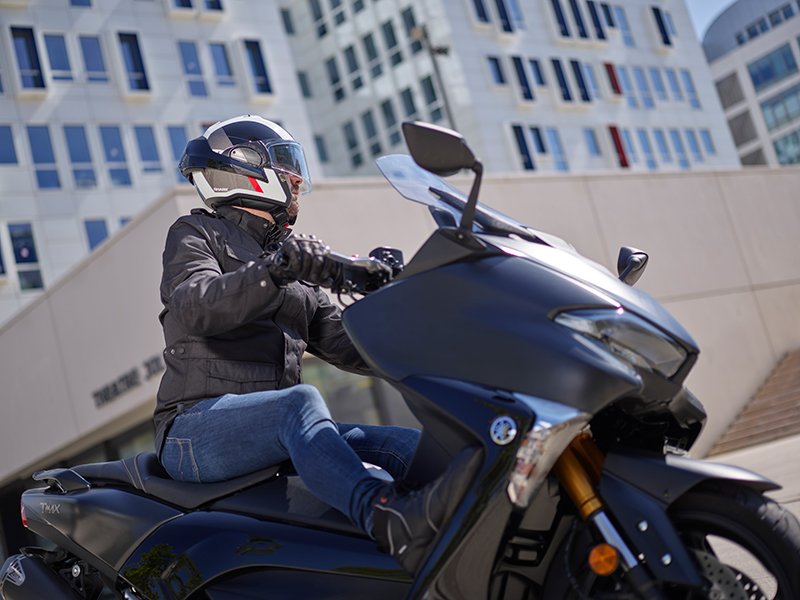
So fun and interesting as they are, these helmets are not perfect. They will suit some people, but if you do most of your riding out of town, a helmet like this might not be for you.
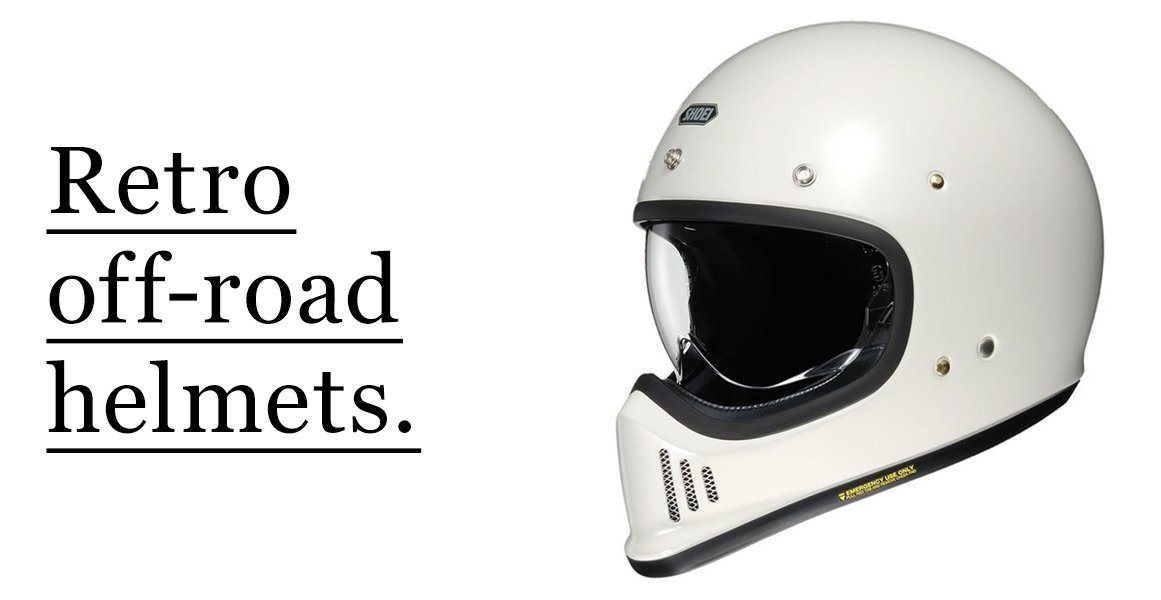
This genre of helmet is fairly new to the market. Bell was first on the scene with its Moto 3. Then came Shoei with its Ex-Zero. The style has since been adopted by a number of what one might call the ‘style’ brands.
These helmets are based on the design of off-road helmets from the seventies and eighties. The important thing to understand, however, is that these helmets are aimed at road riders, not off road riders. If you ride seriously off-road you’d get yourself a proper off road helmet. This having been said, these helmets will suit some adventure bike riders; and indeed I rode in an Ex-Zero on a trip to the Sahara a couple of years ago. It worked fine.
They are, it has to be said, designed to offer the riders of modern scramblers an appropriate form of headwear. As a company, we rarely submit to the demands of fashion and style alone, but we really like these helmets for a reason that was perhaps not envisaged when these helmets were first re-introduced to the market.
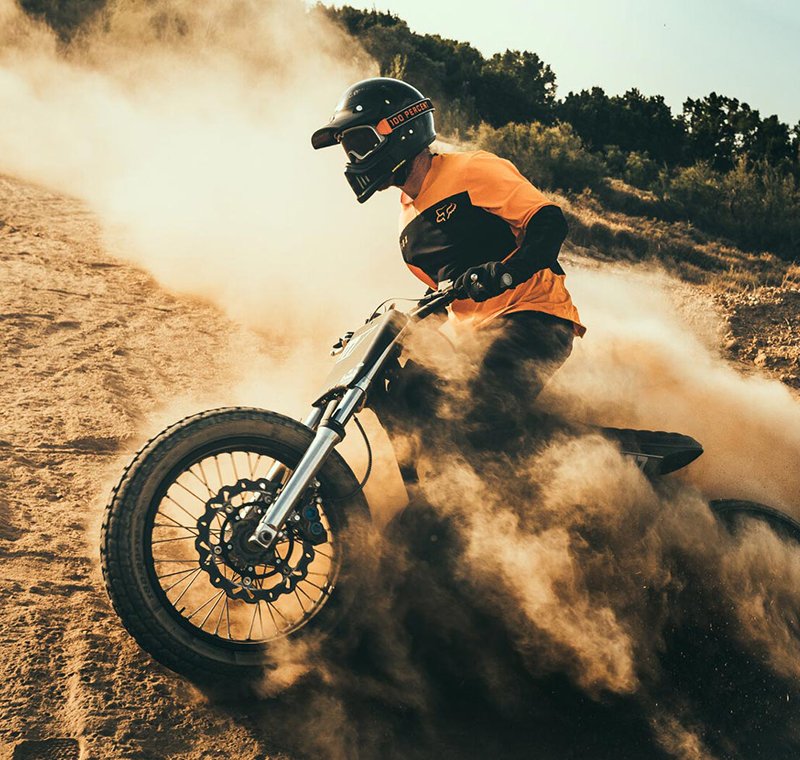
We see them as open-face helmets for those who don’t want to risk the possibility of losing their chins. The fact is that they give you that wind-in your-hair feeling that you get with an open-face helmet, but if it does go Peter Tong, your chin is protected. And we like that; some of the benefits of an open face combined with some of the benefits of a full-face helmet.
For eye protection, you can easily wear goggles. Some, though, like the Ex-Zero have a drop-down visor. Of course, in the rain these helmets are not great, but then neither is an open face. They do, though, look the business!
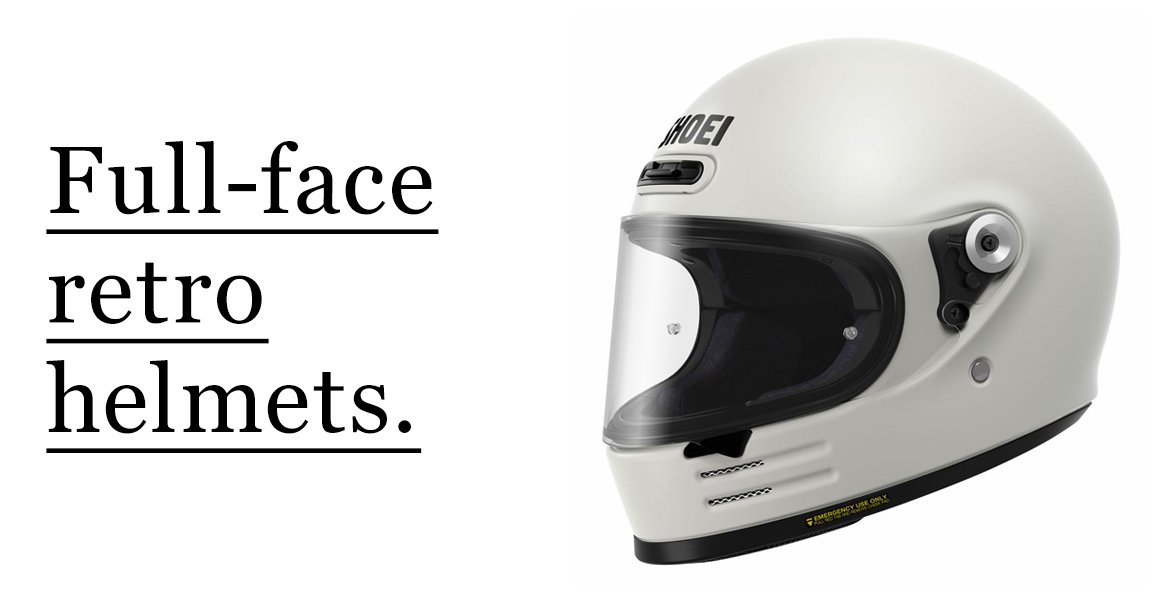
This is a category of helmet that is quite close to our hearts, because we have a lot of customers who ride classics, modern retros, custom bikes or cruisers.
The first full-face retro helmet was introduced by Bell back in 2014. The helmet was called the Bullit, and it was a revelation; a super-cool looking full-face. It sold like Billy-O, and over the years that followed it was copied by just about everybody. And like the original many of these helmets looked fantastic.
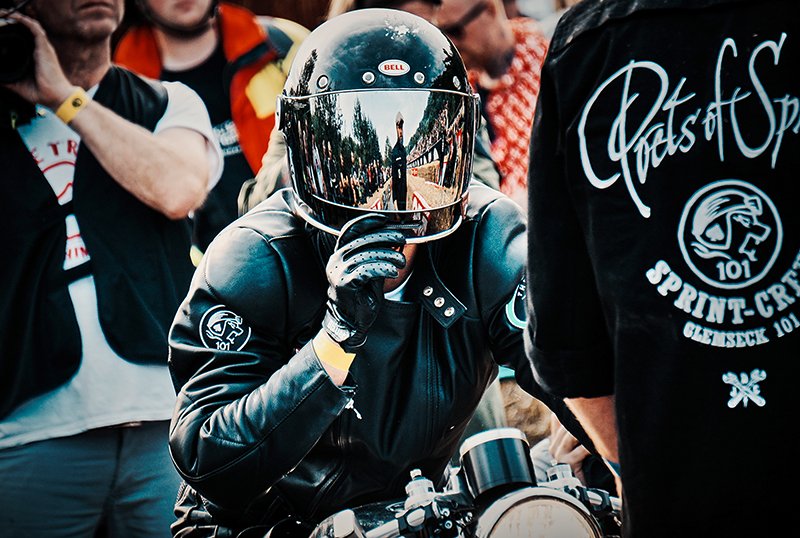
But, by the same token, most of them, including the Bell original, were horribly compromised. Frankly most of these so-called retro helmets were just rubbish; and still are. They were invariably noisy. Chin curtains were unheard of. The sealing of the visor was poor, adding to the noise issue, and allowing rain to get in. Venting was either non-existent or permanently open. None had changeable interior parts, and very, very few could take an anti-fog insert.
They really were all about style. They weren’t great for riding in. And one of the key reasons for their failings was that they were designed from the outside rather than from the inside. This meant you got a beautifully smooth, outer shell, but very few designers gave much thought to what it would be like riding in one of these helmets. And as a result they didn’t fit many people particularly well.
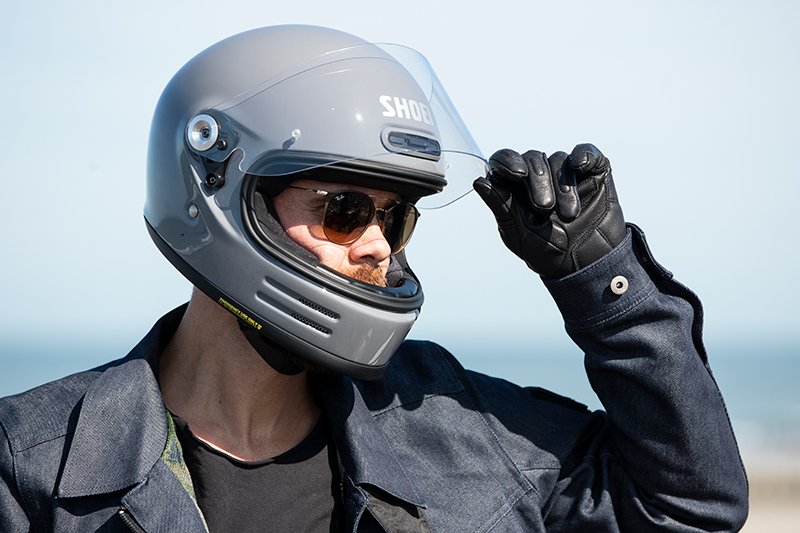
But this niche category was spared its blushes when both Arai and Shoei came out with retro-inspired helmets that brooked no compromise. Thes guys make the world’s best and safest helmets, and their retro offerings allow retailers to custom fit these helmets like any other Arai or Shoei. You get proper venting, watertight seals, chin curtains, Pinlock visors. In every way these helmets are modern helmets. They just look cooler!
And what this means is that you can now ride you’re rNineT, your Z900rs, your Triumph Bonneville or Guzzi V7 without having to compromise on comfort and safety.
It’s easy for us to say that you should find a dealer who really knows how to fit a helmet. But sadly not every dealer cares enough to help you get it right. But buying online on the basis of the circumference of your head is like a turkey shoot. It’s all down to luck.
But what we hope we have done here is to give you a bit of a handle on the different styles of helmet out there, and who they are aimed at. Hopefully, this will narrow down the search a bit.
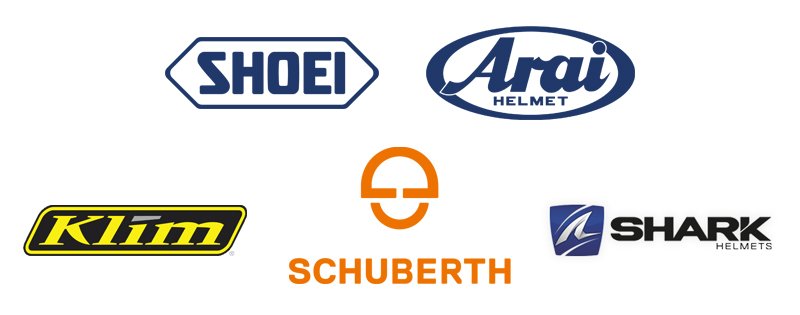
Of course, if you can make it you’re welcome to visit us here in Guildford, but the range of helmets we offer is quite narrow. We’d like to think that we’ve gone for quality over quantity. We sell Shoei, Arai, Schuberth. Some Shark helmets, the Klim Krios Pro helmet and the Scorpion ADF-9000.
Our helmets are not cheap. There’s not a lot that we offer that costs less than £300; and this night not work for you. But we don’t rate cheap helmets, so we don’t sell them. By the same token, we don’t sell silly-expensive helmets. Spend a thousand pounds on a helmet and you won’t get better functionality than you would if you spent £500. You just get bragging rights.
Getting the right helmet is not easy. It can take some time, but knowing from the outset the type of helmet you want can only make the quest easier.
You might also want to read when you should replace your motorcycle helmet.
Click to shop motorcycle helmets.
Share this story
































































